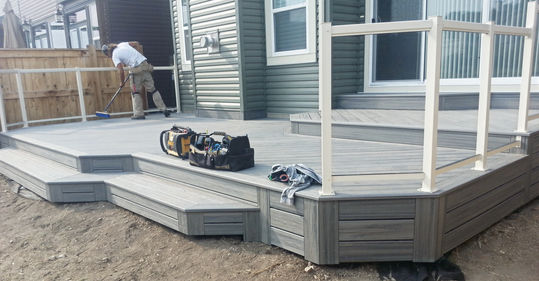
Quality Composite Decks using Trex, Deckorators, TimberTech & More.
In this section, we explore everything you need to know about composite decking. From the numerous advantages of using high-quality materials like Trex to essential maintenance tips for longevity, we’ll offer a comprehensive guide to help you make informed choices for your outdoor living area. Whether you're considering a new installation or looking to upgrade your existing space, understanding the benefits of composite decks will empower you to create the perfect outdoor retreat.
What is composite?
The primary materials in composite decking boards are wood fibers and plastic. The ratio of wood to plastic varies from brand to brand. Typically, composite decking incorporates polypropylene or polyethylene plastic, which works well with wood fibers to create a material that is stronger and more resilient than 100% plastic decking.
Did you know?
-
WPC (wood plastic composite) is also a sustainable material when building a composite deck, and offers excellent resistance to weather and daily wear and tear. But before you build a deck, it pays to be prepared so you can save time, money, and effort—all to ensure a successful project.
-
Not all WPC's are made equal. We only use quality products so neither of us will have to worry.

What are the benefits of a composite deck?
Key benefits of a composite deck boards:
Low maintenance
-
Composite decking requires little upkeep and doesn't need to be painted or stained
-
It's easy to clean
Durability
-
Composite decking is resistant to warping, splintering, rotting, and insect damage
-
It's also resistant to moderate scratches and stains
Weather resistance
-
Composite decking is less likely to be damaged by weather conditions than traditional wood
-
It expands and contracts less than wood
Environmental friendliness
-
Composite decking can be made from recycled materials
Safety
-
Composite decking is slip resistant and safe for bare feet
Appearance
-
Composite decking comes in a variety of colors and finishes
Home value
-
A composite deck can increase the value of your home
Installation
-
Composite decking can be installed using top-down fasteners or hidden clips

Are there any disadvantages to using composite deck boards?
Will my boards swell like this?
The short answer; possibly. However, when using wood based composites, we frame so that there is a cavity under the join. This allows air to circulate and prevents water from pooling. No water, no swelling.
Surely it's easy to clean?
Yes! Just scub it with warm soapy water, then rince.
Composite decking can have several disadvantages, including fading, warping, and mold. It's important to go with a reputable brand as a way of avoiding these issues.
Fading
-
Over time, composite decking can fade due to exposure to sunlight.
-
UV rays break down the chemical bonds in the decking material.
Warping
-
Composite decking can warp in hot weather.
-
Wood-based composites have a higher chance of warping than mineral-based composites.
-
Water can get inside the board and cause swelling.
Mold
-
Composite decking can still develop mold.
-
Wood molds and rots when exposed to moisture.
-
Uncapped wood composite boards leave their organic ingredients vulnerable to the elements.
Slippery
-
Composite decks can become slippery when wet.
-
To reduce slipping, you can use textured boards or install non-slip decking strips.
Temperature sensitivity
-
PVC decks can become quite hot underfoot in direct sunlight.
-
They can also expand and contract with temperature changes.
Price
-
Composite decking is generally more expensive than wood decking.


















